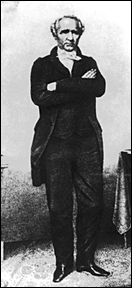Houston & Technology
 Today men and women travel hundreds of thousands of miles on space shuttle missions that last a week--about as long as it took Sam Houston for a one-way trip between Texas and Washington in the late 1850s.
Today men and women travel hundreds of thousands of miles on space shuttle missions that last a week--about as long as it took Sam Houston for a one-way trip between Texas and Washington in the late 1850s.
Astronauts traveled to the moon and back in about that amount of time, and the first words communicated by Astronaut Neil Armstrong from the moon's surface were "Houston, Tranquility Base here. The Eagle has landed."
Sam Houston would have appreciated the technology, and the compliment.
Although Houston was a visionary, an orator, and an architect of empires, he was also concerned with the technology of his time, especially military, and a pretty fair gunsmith, as indicated by an incident related by Marquis James in "The Raven."
When Houston was retreating before Santa Anna's Mexican army in April of 1836, he had many problems. His army was outnumbered and ill-equipped, the president of the provisional government was a political enemy who harangued him to stop and fight, and there was talk of his officers trying to replace him as commander.
His spirits were lifted, however, by the arrival in camp of two six-pound artillery pieces, sent by friends in Cincinnati. Wearing an old leather jacket and looking nothing like a general, he was watching the camp blacksmith cut up discarded horseshoes for artillery ammunition when a young soldier approached with a broken rifle. James recounted the conversation.
"All right, son," Houston is said to have told the boy, "set her down and call around in an hour."
"The boy came back, stammering an apology," James wrote. "He was a recruit, he said, and did not know that the man pointed out to him as a blacksmith was the commander-in-chief."
"My friend, he told you right," Houston is said to have replied. "I am a very good blacksmith." He held out the gun and snapped its lock. "She is in order now."
In later years, when Houston was serving his 13 years as U. S. Senator from Texas, the age of the locomotive was just dawning, but Houston was among the first to recognize its potential.Former Sam Houston State University historian Gregg Cantrell said that when Houston first began traveling to Washington as a U. S. Senator the trip took about six weeks. Toward the end of his service it took about six days.
He wrote to his wife, Margaret, in December, 1848, after completing a return trip to Washington.
"I arrived here last night from a hard journey," he wrote. "For seven days I never had my clothes off me and only lay down just one time and that for the space of four hours. I was exposed to cold and my head has been aching for two days. Tonight I have taken some medicine and I hope to be well by morning."
Only a month later, perhaps with that ordeal fresh in mind, Houston introduced a Senate resolution for construction of a railroad to the Pacific. He favored a southern route, through Texas.
"The earliest development," he said of the territories whose acquisition had been made possible by his army's victory at San Jacinto, "of which is of the highest importance in the advancement of the prosperity of the country, it becomes us, as a wise people, to take such measures as will insure protection in war as well as in peace, to those distant portions of our Republic."
While certainly an improvement, travel by the iron horse at first was not always that swift or certain.
In 1859, James wrote, "Thanks to the steam cars which with many vicissitudes ran by relays the whole distance to New Orleans the trip to Texas could be accomplished in eight days."
By 1860, wrote James, "a few miles of railway had been laid down in Texas," and "the new and splendid Locomotive" of the Southern Pacific Railroad was named the "Sam Houston."
The advancement of peaceful technology was put on hold, however, as the nation underwent the Civil War. Houston was elected governor but left office because he would not swear allegiance to the Confederacy. But he never stopped dreaming.
He believed the Confederacy could not win the war, and that Texas would be better off separated from it. He foresaw a "protectorate" for Mexico. James wrote:
"His plan was to stop the flow of Texas troops across the Sabine and, at the right moment, declare himself the lawful magistrate of the state, unfurl the Lone Star and call Texans home from the armies of the Confederacy.
"Magnificent prospects spread before the grim dreamer. He foresaw in fifteen years' time steam cars running from the Brazos to Mexico City."
It was not to be, of course. He died less than a year later--July 26, 1863--but it was a starry-eyed vision that said a lot about the man whose name was the first word communicated from the moon.
Text by: Frank Krystyniak
